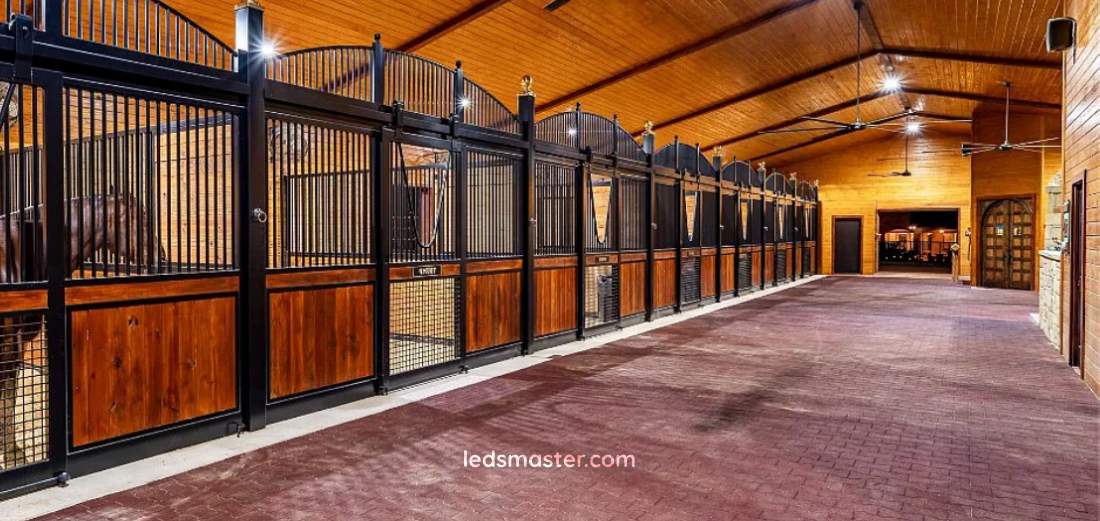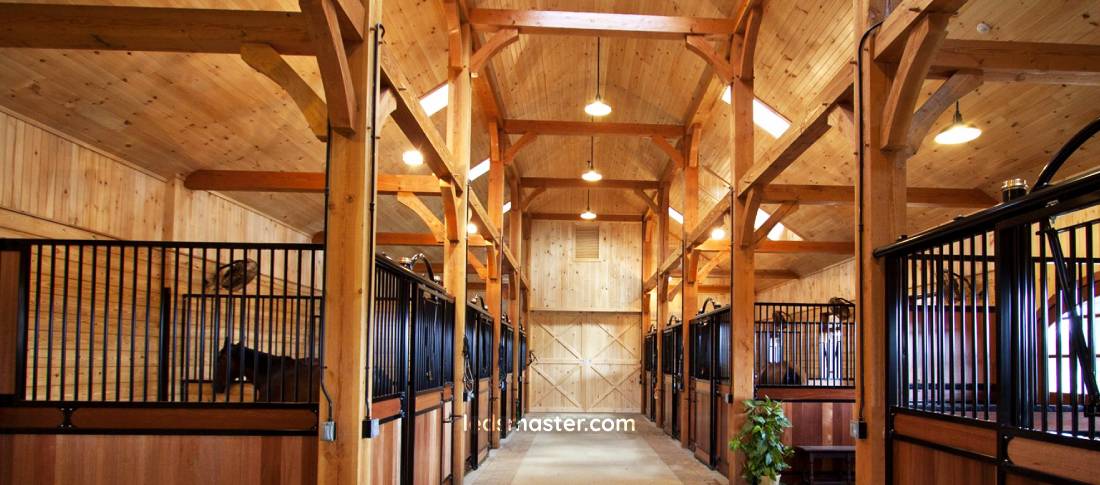Our premium, glare-free horse stall lighting ensures a comfortable and soothing environment. Designed to prevent eye strain, it creates a relaxing ambiance that keeps your horse calm and content. Experience optimal brightness and tranquility with our horse-friendly lighting solution.
The quality and type of lighting can impact a horse’s comfort, behavior, and overall health. This article explores the importance of horse stall lighting, focusing on how it affects horses’ eyes and health, and provides guidelines for creating the optimal lighting environment in your stable.
Get your complimentary lighting design today
Table of Contents
ToggleLighting in horse stalls serves multiple purposes. It ensures safety, enhances the ease of daily tasks for caretakers, and significantly affects the health and behavior of the horses. Horses, like humans, require a balance of light and darkness to regulate their circadian rhythms, which influence their sleep patterns, hormone levels, and overall health.
Horses have a unique visual system that differs from humans. They have a wide field of vision, approximately 350 degrees, which helps them detect predators. However, their ability to see fine details and colors is less developed. Horses are more sensitive to blue and green light and less sensitive to red. This means that the type and intensity of light used in horse stalls can affect how comfortable and secure horses feel in their environment.

Horses, like all mammals, possess natural biological clocks that regulate their circadian rhythms. These rhythms influence numerous bodily functions, including sleep-wake cycles, feeding behaviors, and hormonal fluctuations. For horses, proper lighting is crucial in maintaining these rhythms, which can be disrupted by inconsistent or inadequate light exposure.
Circadian rhythms are intricately linked to light exposure. In nature, horses experience a consistent light cycle that varies throughout the day and across seasons. This natural rhythm allows them to establish predictable patterns for eating, sleeping, and socializing. When horses are kept in environments with improper lighting, their internal clocks can become misaligned. Disruptions to these rhythms can lead to stress, decreased immune function, and behavioral issues, including anxiety and aggression.
To maintain optimal health, provide horses with a lighting environment that mimics natural light cycles. This can be achieved through the use of artificial lighting that replicates the gradual transitions from light to dark. A well-structured lighting schedule can help reinforce natural behaviors, allowing horses to thrive in their environments.
Research has shown that disruptions to circadian rhythms can have profound effects on horses’ physical and mental well-being. Horses that are subjected to constant artificial lighting or abrupt changes in light exposure may experience irregular sleeping patterns, leading to increased stress levels and a heightened risk of developing health problems. Furthermore, such disruptions can affect feeding behavior, leading to changes in digestive health and overall metabolism.
Maintaining a natural light cycle is not only beneficial for the horses’ mental state but also support their immune systems. Properly regulated lighting can enhance their overall resilience against illnesses and diseases, ensuring they remain healthy and active.
Horses have large, sensitive eyes that are designed to detect movement and perceive their environment effectively. However, their eyes are particularly susceptible to various lighting conditions, making eye health a crucial aspect of equine care.
The sensitivity of horses’ eyes means they can be adversely affected by intense, direct lighting. Bright, harsh lights can cause discomfort, leading to squinting or other adverse reactions. In extreme cases, excessive exposure to bright lights can damage the retina, resulting in long-term vision problems.
To protect horses’ eye health, provide lighting that minimizes glare and offers soft, diffused illumination. Creating a lighting environment that prioritizes comfort can significantly improve the overall well-being of horses. Lighting options that reduce harshness contribute to a more relaxed atmosphere, allowing horses to feel secure in their surroundings.
Natural light is the best form of illumination for horses. It is soft, balanced, and provides a spectrum of light that supports healthy vision. When designing stables or horse facilities, incorporating windows and skylights can help maximize natural light exposure while reducing reliance on artificial lighting. This integration not only supports eye health but also enhances the overall quality of the living environment.
Moreover, when natural light is available, horses can regulate their light exposure more effectively, allowing them to instinctively adjust to changes in their environment. This ability to self-regulate is vital for maintaining overall health and comfort.
Seasonal Affective Disorder (SAD) is a condition that affects not only humans but also horses, particularly during the darker months of winter. Just as humans may experience mood fluctuations due to reduced sunlight exposure, horses can suffer from similar issues, leading to behavioral changes and decreased motivation.
Horses affected by SAD may exhibit symptoms such as lethargy, irritability, and a lack of interest in usual activities. They may also display changes in feeding behavior, becoming more prone to weight gain or loss during the winter months. Recognizing these signs is essential for horse owners, as early intervention can mitigate the effects of SAD.
One effective strategy for alleviating SAD symptoms in horses is ensuring they receive adequate light exposure throughout the year. Increasing light availability, especially during winter months, can help improve mood and behavior. For instance, utilizing artificial lighting that mimics natural daylight can create a more balanced environment for horses, reducing the impact of seasonal changes on their mental health.
Light therapy, often used for humans suffering from SAD, can also be beneficial for horses. This approach involves providing controlled exposure to bright light, typically using specialized lamps designed for this purpose. These lamps can help horses adjust their internal clocks and improve their mood, thereby supporting their overall well-being during darker months.
By actively addressing the effects of seasonal changes on lighting, horse owners can help ensure that their animals remain healthy, happy, and engaged, regardless of the time of year.
Selecting the appropriate type of lighting for equine environments promote comfort and health. Various lighting options are available, each with distinct characteristics that can influence horses’ well-being.
LED lights have gained popularity in horse facilities due to their energy efficiency and long lifespan. These lights produce minimal heat, making them a safe choice for horse stalls. One of the key advantages of LED lighting is its ability to provide consistent light quality that can be adjusted to mimic natural daylight.
Furthermore, LED lights are available in a variety of color temperatures, allowing horse owners to choose a spectrum that is comfortable for their animals. For instance, cooler color temperatures may be more energizing, while warmer tones can create a calming environment. This flexibility makes LED lights an excellent choice for various equine settings, from stables to riding arenas.
Fluorescent lights represent another energy-efficient option for horse facilities. However, they may sometimes flicker, which can be disturbing to horses. To mitigate this issue, high-quality, non-flickering fluorescent bulbs should be used.
Installing fluorescent lights with covers can help diffuse the light and reduce glare. Properly designed fluorescent lighting can create a well-illuminated environment that supports the needs of horses while minimizing distractions that flickering lights may cause.
Incandescent lights provide a warm, soft glow that is gentle on horses’ eyes. While these lights are less energy-efficient and generate more heat compared to LED and fluorescent options, they can be suitable for smaller stables or as supplementary lighting.
Using incandescent bulbs can create a cozy atmosphere that horses may find comforting, particularly during colder months. However, considering their limitations in energy efficiency, it is advisable to use incandescent lights judiciously rather than relying on them as the primary light source.
Integrating natural light into horse facilities can greatly enhance the quality of the environment. Windows, skylights, and transparent panels can provide ample natural daylight, reducing the need for artificial lighting during the day.
The right positioning of natural light sources prevent direct sunlight from shining into horses’ eyes, which can cause discomfort. By achieving a balance of natural and artificial lighting, horse owners can create a stimulating and pleasant environment that supports the physical and emotional needs of their animals.
Creating an effective lighting layout involves strategic planning and consideration of various factors to ensure even and adequate illumination without causing discomfort.
Proper positioning of lights provide even coverage throughout the stall or facility. It is advisable to avoid placing lights directly above feed and water areas to minimize shadows and prevent glare.
Higher placements can reduce light intensity while spreading it more evenly across the space. This thoughtful approach contributes to a balanced lighting environment that allows horses to move comfortably without being distracted or disturbed by harsh lighting conditions.
Horses require different light intensities depending on the time of day and their activity levels. During active hours, brighter lighting—around 150 to 200 lux—is suitable for facilitating movement and engagement. Conversely, dimmer lighting—approximately 50 to 75 lux—is preferable during rest periods, promoting relaxation and recuperation.
Utilizing dimmable lights or timers can assist in regulating both the intensity and duration of lighting. This flexibility helps mimic natural light patterns, contributing to the horses’ overall health and behavior.
Modern technology offers innovative solutions for managing lighting in equine environments. Smart lighting systems can be programmed to adjust automatically based on the time of day or specific activities. These systems can simulate natural light changes, ensuring that horses experience the appropriate lighting conditions throughout the day.
Furthermore, smart sensors can detect the presence of horses in stalls and adjust the lighting accordingly, providing adequate illumination while conserving energy when the space is unoccupied. This level of automation not only enhances the comfort of horses but also promotes energy efficiency and sustainability in horse facilities.

Safety is a paramount concern when installing lighting in horse stalls. Horses are large, powerful animals, and their environments must be free from hazards.
All electrical installations should comply with safety standards to prevent electrical fires and shocks. Use waterproof and dustproof fixtures to protect against the elements and ensure that wiring is well-insulated and out of reach of horses.
Lighting fixtures in horse stalls must be robust and able to withstand the harsh conditions of a stable environment. Choose fixtures made from durable materials that can resist dust, moisture, and impact.
Regular maintenance ensure that the lighting system remains effective and safe. Clean fixtures regularly to remove dust and debris that can reduce light quality. Check for signs of wear and tear, and replace bulbs and fixtures as needed.
Understanding horses’ visual needs and the health implications of lighting helps in designing an optimal lighting environment. Whether using LED, fluorescent, or incandescent lights, the key is to provide even, glare-free illumination that mimics natural light patterns. By carefully selecting and positioning lights, integrating natural light, and ensuring safety and regular maintenance, you can create a comfortable and healthy space for your horses.